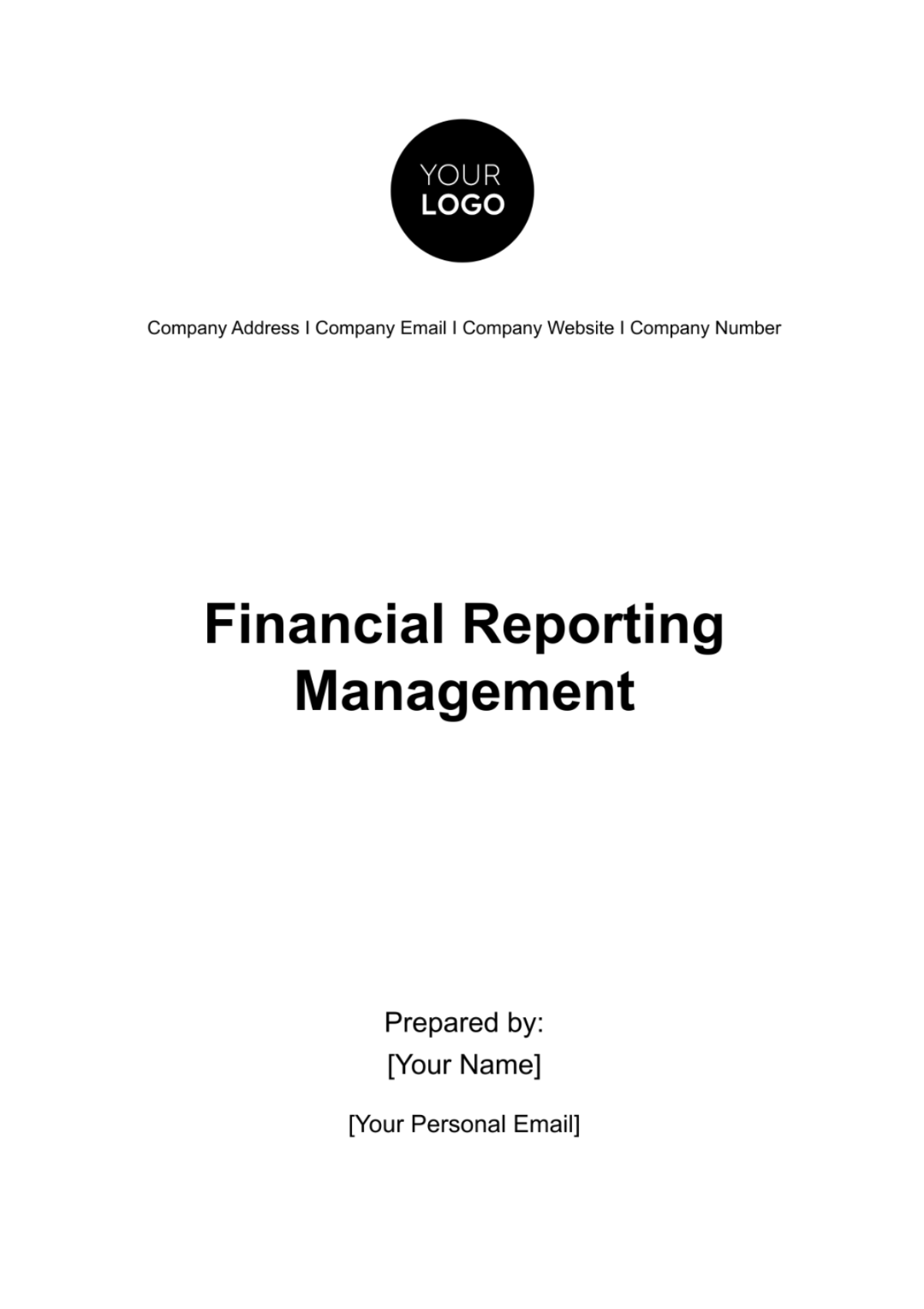Free Financial Reporting Management

Executive Summary
A. Overview
[Your Company Name] presents this Financial Reporting Management report to provide a concise overview of the financial performance and reporting activities. In the fiscal year [2050], [Your Company Name] has demonstrated robust financial health and continued growth in its market presence.
B. Key Highlights
In the past year, [Your Company Name] achieved a significant milestone by reaching a total revenue of [$15,000,000]. This growth was primarily driven by a [12%] increase in product sales and successful diversification into new service offerings. Despite global economic challenges, the company effectively managed operating expenses, resulting in a healthy profit margin of [18%].
Financial Performance
A. Revenue Analysis
Revenue Sources
[Your Company Name] derives its revenue from various sources. The following table provides a breakdown of the primary revenue streams:
Revenue Source | Amount |
|---|---|
Product Sales | [$9,000,000] |
Revenue Growth
The table below illustrates the revenue growth over the past two years, showcasing a steady increase in both product sales and service revenue:
Year | Revenue | Growth Rate |
|---|---|---|
[2050] | [$15,000,000] | [12%] |
B. Expense Analysis
Operating Expenses
Operating expenses for [Your Company Name] encompass various categories. The following table details the major components:
Expense Category | Amount |
|---|---|
Salaries | [$4,500,000] |
Cost of Goods Sold (COGS)
The cost of goods sold is a critical factor in determining profitability. Here is a breakdown by product or service:
Product/Service | COGS |
|---|---|
Product A | [$4,000,000] |
Financial Reporting Processes
A. Reporting Framework
[Your Company Name] follows a comprehensive financial reporting framework to ensure accuracy, transparency, and compliance. The framework includes adherence to Generally Accepted Accounting Principles (GAAP) and industry-specific standards. This ensures that all financial statements are prepared consistently, allowing for reliable analysis and comparison.
B. Reporting Timelines
Timely financial reporting is crucial for effective decision-making. [Your Company Name] adheres to the following reporting timelines:
Reporting Period | Submission Deadline |
|---|---|
Monthly | 5th of the following month |
Financial Metrics
A. Key Performance Indicators (KPIs)
To measure and assess financial performance, [Your Company Name] monitors key performance indicators. The following KPIs are crucial for evaluating success:
Metric | Target Value | Actual Value |
|---|---|---|
Profit Margin | [20%] | [18%] |
Financial Forecast
A. Budget vs. Actuals
Comparing budgeted figures with actual financial performance provides insights into [Your Company Name]'s financial discipline. Here's a comparison for the current fiscal year:
Category | Budget | Actual |
|---|---|---|
Revenue | [$18,000,000] | [$15,000,000] |
B. Net Profit
The budgeted revenue was [$18,000,000], but due to unforeseen market challenges, the actual revenue for the current fiscal year is [$15,000,000]. While operating expenses were budgeted at [$16,000,000], effective cost management resulted in actual expenses totaling [$14,500,000]. Consequently, the net profit is [$500,000], reflecting a temporary downturn in profitability.
C. Future Projections
Projected values for key financial metrics for the next fiscal year are as follows:
Metric | Projected Value |
|---|---|
Revenue | [$20,000,000] |
The projections for the upcoming fiscal year are optimistic, with anticipated revenue reaching [$20,000,000] and carefully managed operating expenses of [$17,000,000]. The net profit is projected to rise to [$3,000,000], reflecting the implementation of strategic initiatives to enhance profitability.
Risk Analysis
A. Financial Risks
[Your Company Name] identifies the following financial risks that may impact its performance:
Market Volatility: Fluctuations in the market may affect product demand and revenue.
Credit Risk: Non-payment from customers could impact cash flow.
Operational Risks: Disruptions in operations may lead to increased expenses.
B. Risk Mitigation Strategies
To mitigate these risks, [Your Company Name] will implement the following strategies:
Diversification: Explore new markets to reduce reliance on a specific segment.
Credit Assessment: Implement rigorous credit assessments for customers.
Operational Efficiency: Invest in technology and process improvements for enhanced operational resilience.
Financial Compliance and Governance
A. Regulatory Compliance
[Your Company Name] diligently adheres to regulatory standards and financial compliance requirements to maintain the highest level of integrity in its operations. Regular assessments and updates are conducted to ensure that the company stays abreast of changes in regulations, minimizing the risk of legal and financial repercussions.
B. Governance Structure
The governance structure at [Your Company Name] is designed to foster transparency and accountability. The Finance Committee, composed of experienced professionals, plays a pivotal role in overseeing financial reporting activities. Regular meetings and audits ensure that the governance structure remains effective in safeguarding the accuracy and reliability of financial information.
Technology Integration for Financial Reporting
A. Financial Reporting Systems
[Your Company Name] leverages cutting-edge financial reporting systems to maintain a competitive edge in the industry. These systems are tailored to the specific needs of [Your Company Name] and are continuously updated to align with the latest technological advancements.
B. Automation and Artificial Intelligence
Recognizing the transformative power of automation and artificial intelligence, [Your Company Name] has implemented advanced technologies to streamline financial reporting processes. This includes the automation of routine tasks, reducing the margin of error and allowing financial professionals to focus on strategic analysis.
Sustainability and Environmental, Social, and Governance Reporting
A. Sustainable Financial Practices
Sustainability is a cornerstone of [Your Company Name]'s values. The company actively incorporates sustainable financial practices into its reporting framework. This includes:
Environmental Impact: Regular assessments of the environmental impact of operations to identify and implement eco-friendly initiatives.
Ethical Business Practices: Promoting ethical business practices, ensuring transparency in financial reporting, and upholding the highest standards of integrity.
Social Responsibility: Contributing to social initiatives and community development to fulfill [Your Company Name]'s commitment to social responsibility.
B. ESG Metrics and Reporting
Recognizing the growing importance of ESG considerations, [Your Company Name] has integrated ESG metrics into its financial reporting. Key focus areas include:
Carbon Footprint: Tracking and reporting on the company's carbon emissions to address environmental impact.
Diversity and Inclusion: Monitoring and reporting on diversity metrics to foster an inclusive and equitable workplace.
Governance Practices: Providing insights into governance practices, including board structures and decision-making processes.
By incorporating ESG metrics, [Your Company Name] aims to enhance transparency, accountability, and stakeholder trust, showcasing its commitment to sustainable and responsible business practices.
Recommendations
A. Strategic Financial Initiatives
Based on the analysis, [Your Company Name] proposes the following strategic financial initiatives to enhance performance and mitigate risks:
Product Diversification: Expand the product portfolio to tap into new markets and reduce reliance on specific products.
Cost Optimization: Continue optimizing operational costs through process efficiencies and technology investments to maintain a competitive edge.
Market Expansion: Explore strategic partnerships or acquisitions to enter new markets and increase revenue streams.
Risk Management: Enhance risk management strategies, including robust credit assessment procedures and regular market analyses.
Conclusion
[Your Company Name] has shown resilience in the face of economic challenges, with a focus on strategic financial management. While the current fiscal year experienced a temporary dip in profitability, the projections for the next year are optimistic, supported by proactive initiatives. The implementation of strategic recommendations is expected to position [Your Company Name] for sustained growth and financial stability.
- 100% Customizable, free editor
- Access 1 Million+ Templates, photo’s & graphics
- Download or share as a template
- Click and replace photos, graphics, text, backgrounds
- Resize, crop, AI write & more
- Access advanced editor
Optimize financial reporting with the Financial Reporting Management Template on Template.net. This editable and customizable template streamlines the reporting process. Tailor content effortlessly using our Ai Editor Tool, ensuring adaptability and precision. Elevate your financial documentation with this user-friendly template, offering a comprehensive approach to crafting personalized reporting management documents for effective financial communication and analysis.





























